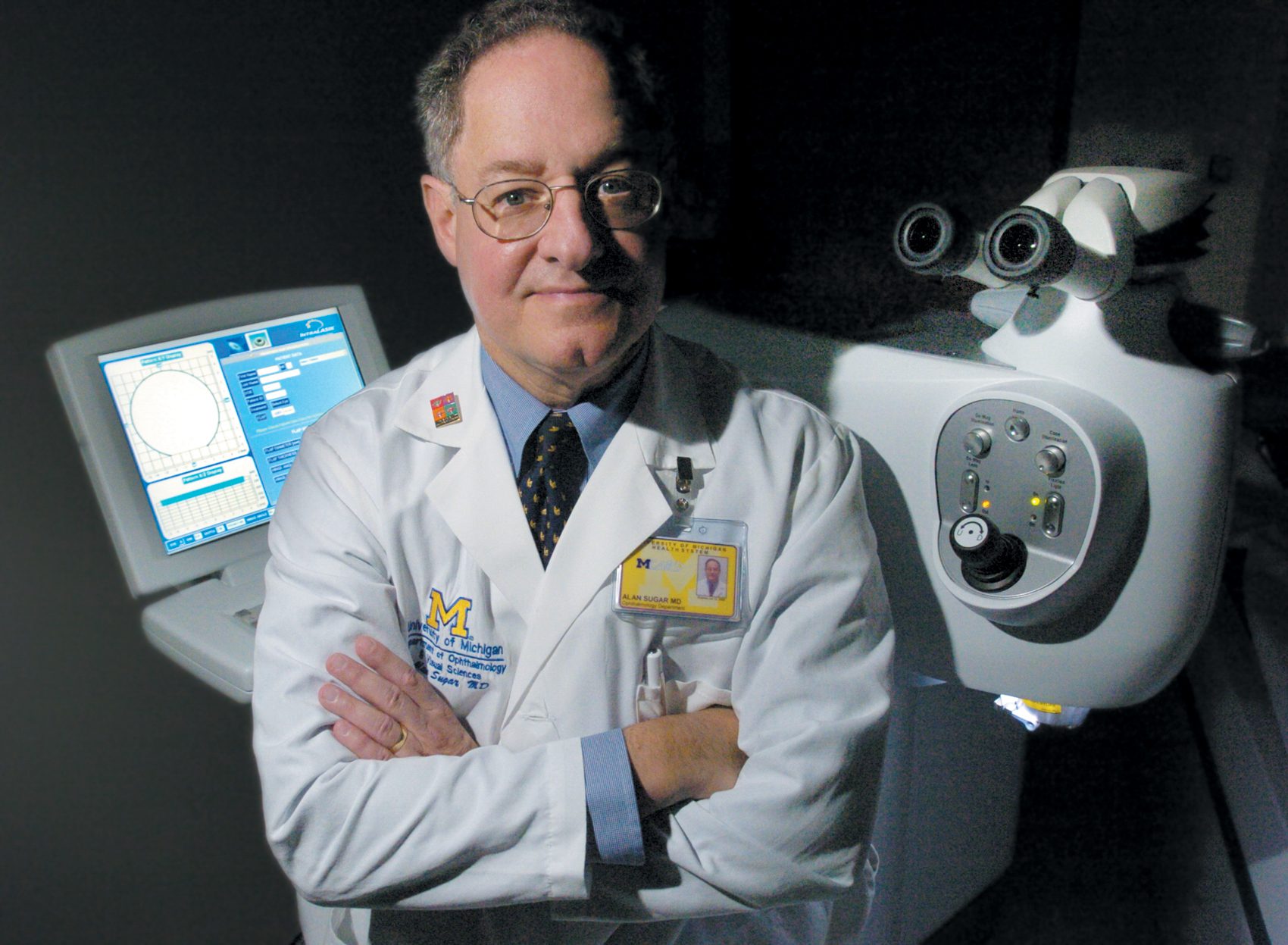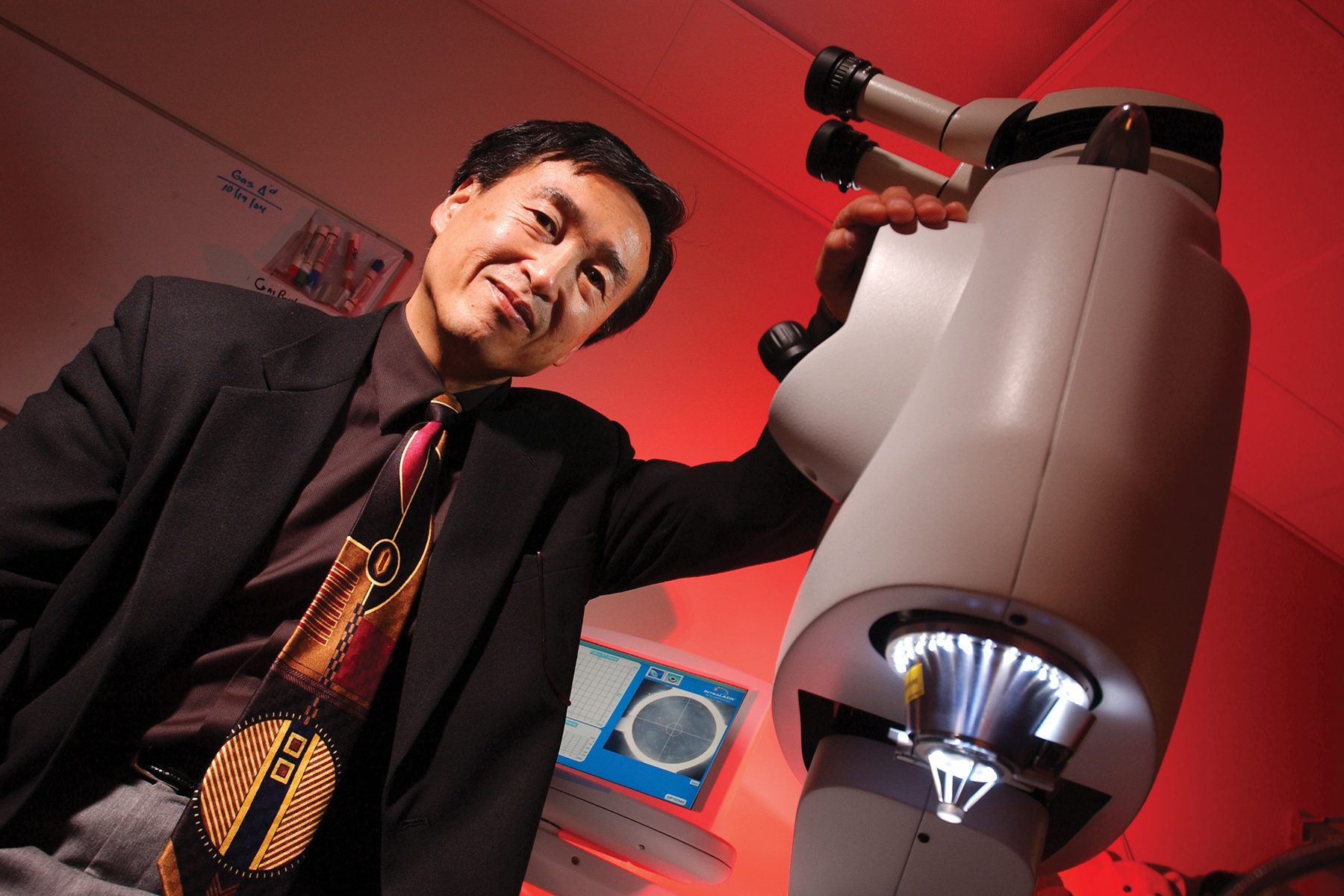There are estimates that more than 24 million people worldwide have experienced improved vision and independence from glasses and contact lenses, thanks to bladeless LASIK, which was serendipitously discovered at the University of Michigan more than 30 years ago.
The National Science Foundation (NSF) has highlighted the role that U-M’s Center for Ultrafast Optical Science (CUOS) played in 1993, when U-M graduate student Detao Du suffered an accidental laser injury to his eye when he momentarily lifted his safety goggles while in the lab. To verify there was no hidden damage, Du went to U-M’s Kellogg Eye Center for evaluation, where Ron Kurtz, a resident in Ophthalmology and Visual Sciences, was assigned to assess Du’s injury. Kurtz determined that the CUOS femtosecond laser, which emits pulses of light with a duration of one-quadrillionth of a second (equivalent to one-millionth of one-billionth of a second), left a series of pinpoint laser burns in the center of Du’s retina without damaging adjacent tissue.
According to the NSF, that incident sparked a collaboration that would result in a revolutionary approach to corrective eye surgery, commonly known as LASIK. Bladeless LASIK, or laser in situ keratomileusis, uses a femtosecond laser rather than a scalpel to cut into the cornea before it is reshaped to improve the patient’s vision.
“The development of bladeless LASIK is reflective of the incredible collaborative culture at University of Michigan between scientists and clinicians in the Department of Ophthalmology and Visual Sciences, Kellogg Eye Center and the School of Engineering.”
“Use of the femtosecond laser for LASIK not only enhanced the safety of the procedure but also allowed us to offer the procedure to patients who otherwise did not qualify for LASIK,” said Shahzad I. Mian, M.D., chair of the Department of Ophthalmology and Visual Sciences and the director of the Kellogg Eye Center. “Bladeless LASIK improved the precision of the procedure and allowed us to provide predictable outcomes to patients.”
Kurtz met with French physicist Gérard Mourou–who had established CUOS. and his team, to discuss laser safety in the lab, and to explore if the lasers the team was developing could be clinically useful. Donna Strickland, one of only a handful of women pursuing a Ph.D. in physics at the University of Rochester at the time, had worked with Mourou in early developments of chirped pulse amplification (CPA), which allows for short, intense laser pulses that precisely vaporize specific points without affecting surrounding tissue. CPA was the basis for the laser tests conducted in Mourou’s U-M CUOS research.
In 1994, Kurtz connected with Tibor Juhasz, Ph.D., at a professional conference. Juhasz had been consulting with a company that was developing short pulse lasers for eye surgery, but the lasers they used simply couldn’t do the job. Mourou brought Juhasz to CUOS as research associate professor in ophthalmology and biomedical engineering at U-M, thanks to the funding provided through the federal government, to further develop the technology. Juhasz was an Associate Professor in Biomedical Engineering from 1998 – 2004.

The NSF funded U-M’s CUOS between 1990 and 2001. Along with support from the U.S. Department of Energy, the National Institutes of Health, the NSF and other federal agencies, U-M researchers had the funding necessary to develop the LASIK approach to vision correction, providing improved eyesight to millions of people. U-M recognized the potential of the societal impact and economic value of this research, and also committed university funds to help expand and accelerate the work. Additional funding came from NIH and NSF through the Small Business Innovation Research (SBIR) program. Together, Kurtz, along with Tibor Juhasz–who collaborated as a core faculty member in U-M biomedical engineering with the clinical faculty-and the CUOS lab contributed to developing LASIK corrective eye surgery that left the surrounding tissue untouched. Going back to 1980, the NSF had supported Mourou with several awards for cross-disciplinary work in physics, materials, electrical engineering and biology. NSF funding helped Mourou establish a biological physics facility at the University of Rochester, and the CUOS at the University of Michigan, which now bears his name. NSF support also helped transition technology developed in Mourou’s labs to commercial applications.
In 1997, Drs. Juhasz and Kurtz co-founded IntraLase with the help of the technology transfer office (now known as Innovation Partnerships) – giving the world access to bladeless eye surgery for corrective eye surgery.
“The development of bladeless LASIK is reflective of the incredible collaborative culture at University of Michigan between scientists and clinicians in the Department of Ophthalmology and Visual Sciences, Kellogg Eye Center and the School of Engineering,” Mian said.


In 2022, the key researchers involved with this discovery received the Golden Goose Award, presented by the American Association for the Advancement of Science, in honor of their scientific breakthroughs that led to the development of bladeless LASIK. The Golden Goose Award honors scientists whose federally funded research has unexpectedly benefited society. The team members recognized were Tibor Juhasz, a former research associate professor in ophthalmology and biomedical engineering at U-M; Ron Kurtz, a former assistant professor of ophthalmology at U-M; Michigan alum Detao Du, A. D. Moore Distinguished University Professor Emeritus Gérard Mourou; and Donna Strickland, who shared the 2018 Nobel Prize in physics with Mourou for a “method of generating high- intensity, ultra-short optical pulses”
The following authors also contributed to this article: Ananya Sen and Kelly Malcom.
This research is supported by the Kellogg Clinical Research Center Gift Fund.
Learn more: https://giving.umich.edu/um/w/kellogg-clinical-research-center-gift-fund-328572
